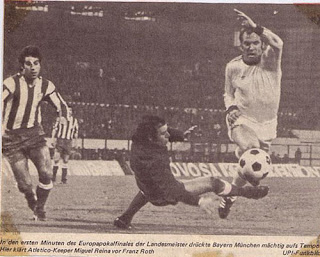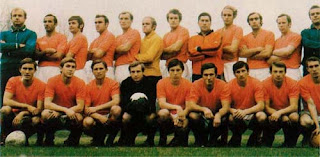At the beginning of the 1970s, the mood was optimistic: new money and opportunities combined with total football were looking great. Yet, very soon an evidence of crisis was equally present – domestic championships suffered. Some countries reorganized their leagues – no matter what was said, it was depressing reduction of formats and clubs started to disappear. Austria ended 1973-74 season with the traditional format of 16 clubs league. Next season the league was ‘reformed’ and reduced to 10 clubs. Fiscal stability was required on one hand (and Austrians are strict about that to this very day). The other reason was the quality of football: it was clear that there were not enough good players for 16-team format. Financial stability with better competitiveness was believed to increase the quality of Austrian football. Well, the reform did not help – a string of mergers, name changes, and bankruptcies characterize Austrian domestic football ever since. Sponsor’s names were incorporated often into club names, to confuse the situation further. An example: the Innsbruck club, one of the most successful Austrian clubs, ended 1970-71 still FC Wacker. In the summer it merged with WSG Swarovski (Wattens) under the name FC Tirol. Other Tyrolean clubs protested and the federation ordered the new club to change the name – now it was SG Swarovski-Wattens-Wacker (Innsbruck), abbreviated to SSW Wacker. Under this name the club was champion next season. Since the world famous firm Swarovski was part of the venture, the future was to be… bright? In 1975-76 the name was changed to Swarovski-Schwarz-Weiss Tirol (Innsbruck) or SSW Tirol. Under this name the club finished last in 1978-79 and was relegated. The name changed to WSG Swarovski Wacker. In 1980-81, still in the second league, the club split to WSG Swarovski (Wattens) and SG Sparkasse Wacker (Innsbruck) (Sparkasse is a bank). Next year the Innsbruck club was renamed again to FC Wacker. In 1985-86 it was FC Swarovski-Tirol. In 1991-92 – FC Wacker again. Next season: FC Capillaris Tirol. In 1994-95 – FC Tirol. In 1997-98: FC Tirol-Milch. Today it is Wacker again, freshly renamed from Wacker Tirol on July 1,2007. At least the club stays in one city.
But here is the final Austrian table for 1973-74:
Austria 1973/74Nationalliga
1.VÖEST Linz 32 18 11 3 51-28 47
2.Wacker Innsbruck 32 19 8 5 57-21 46
3.SK Rapid 32 18 9 5 74-33 45
4.FK Austria/WAC 32 16 7 9 59-37 39
5.SK Sturm Graz 32 14 6 12 28-35 34
6.Donawitzer SV Alpine 32 13 7 12 51-48 33
7.FC Admira/Wacker 32 11 9 12 50-48 31
8.SV Austria Salzburg 32 10 11 11 35-35 31
9.Linzer ASK 32 11 8 13 38-48 30
10.Wiener Sport-Club 32 10 9 13 43-60 29
11.1. Simmeringer SC 32 10 8 14 49-47 28
12.Grazer AK 32 9 10 13 31-41 28
13.SC Eisenstadt 32 11 6 15 36-52 28
14.Austria Klagenfurt 32 8 11 13 33-44 27
15.Radenthein/Villacher SV 32 6 14 12 33-40 26
16.First Vienna FC 32 8 8 16 38-54 24
17.FC Vorarlberg 32 5 8 19 31-66 18
Compare to the current league:
Austria 2007/08
First Level (Bundesliga) Table:
1.SK Rapid Wien 31 16 6 9 57-33 54
2.RB Salzburg 31 15 8 8 53-37 53
3.LASK Linz 31 14 10 7 50-39 52
4.FK Austria Wien 31 12 12 7 38-29 48
5.SK Sturm Graz 31 12 11 8 52-34 47
6.SV Mattersburg 31 10 13 8 46-39 43
7.SV Ried 31 10 6 15 36-48 36
8.SC Rheindorf Altach 31 7 10 14 33-55 31
9.SK Austria Kärnten 31 7 7 17 21-51 28 [*2]
-----------------------------------------------------
10.FC Wacker Innsbruck 31 5 11 15 29-50 26 [*1]
[*1] Wacker Tirol changed name to Wacker Innsbruck on July 1, 2007[*2] Pasching moved to Klagenfurt and changed name to Austria Kärnten
Financial stability somehow never came even for the big clubs. It is hard to support a club changing names almost every year. Gates are low, in part because of that. Old clubs sunk or disappeared altogether – Grazer AK, Wiener Sport-club, First Vienna FC and others.
It was not only Austria – Belgium and Scotland were early victims of the 1970s too. 1974-75 was the last traditional 1st division of 18 clubs. Low attendance, low game quality, bad stadiums, and financial difficulties urged the Scottish Federation to introduce reforms – instead of 1st Division, a new Scottish Premier Division was unveiled. 10 clubs. Today it is increased to 12, but did it solve any problems? Yes, the new name sounds grand…
Belgium, in contrast, did not reduce the league size – actually, the league was enlarged from 16 clubs in 1973-74 to 20 in 1974-75. Today – 18, the number established in 1976-77. But the clubs?
The final table of the last ‘small season’Season 1973-1974
First Division
1 RSC Anderlechtois 30 17 6 7 72 38 41
2 R. Antwerp FC 30 15 6 9 48 33 39
3 RWD Molenbeek 30 13 4 13 50 25 39
4 R. Standard de Liège 30 12 8 10 43 30 34
5 Club Brugge KV 30 13 11 6 61 43 32
6 RFC Liégeois 30 11 10 9 42 42 31
7 KV Mechelen 30 10 9 11 34 35 31
8 KSV Cercle Brugge 30 8 11 11 46 48 27
9 KSV Waregem 30 8 11 11 38 49 27
10 SK Beveren 30 7 10 13 24 30 27
11 R. Beringen FC 30 9 13 8 29 48 26
12 FC Diest 30 8 12 10 44 51 26
13 Beerschot VAV 30 8 12 10 36 47 26
14 Berchem Sport 30 7 11 12 33 45 26
15 K.Lierse SK 30 6 11 13 35 51 25
16 R. St.-Truidense VV 30 6 13 11 30 50 23
and the current season:
Belgium 2007/08Table:
1.R. Standard de Liège 27 17 10 0 51-17 61
2.Club Brugge KV 27 16 6 5 34-20 54
3.Cercle Brugge KSV 27 15 7 5 55-25 52
4.RSC Anderlecht 27 15 7 5 44-26 52
5.KFC Germinal Beerschot 27 14 6 7 40-24 48
6.KAA Gent 27 12 8 7 49-36 44
7.SV Zulte-Waregem 27 11 5 11 36-44 38
8.KVC Westerlo 27 10 8 9 38-28 38
9.KRC Genk 27 9 8 10 39-42 35
10.R. Charleroi SC 27 9 6 12 27-34 33
11.KV Mechelen 27 8 8 11 34-40 32
12.R. Excelsior Mouscron 27 8 6 13 31-37 30
13.KSC Lokeren OV 27 6 12 9 21-26 30
14.FC Verbroedering Dender EH 27 8 5 14 27-43 29
15.KSV Roeselare 27 6 9 12 29-47 27
16.RAEC Mons 27 6 7 14 30-41 25
-------------------------------------------------------
17.K. Sint-Truiden VV 27 4 8 15 23-44 20
18.FC Brussels 27 4 4 19 22-56 16
After mergers, bankruptcies, movements, splits, and new amalgamations, one has to go to club histories and careful encrypting of the abbreviations to uncover what happened. Here the mergers were not only between clubs of one city – more often clubs of different cities merged. And later dissolved. And merged again. Take Racing White (Brussels), the Belgian champions for 1974-75. The details are too many to be traced here, but it was a club of previous mergers – Racing and White Star Club (the oldest of all incorporated). Before the start of their glorious season, they merged with Daring Club (Brussels), technically more famous club than Racing White. Main reason was low attendance. Legal reasons – rules of registration – forbid the new club to use the old record of Daring Club. And probably to preserve some coherence, in Europe the club was better known as Racing Club, but in Belgium it was R.W.D. Molenbeek (Brussels). Until 2002, when the club went bankrupt. Did it disappear? Not at all – it merged with K.F.C. Strombeek, located near Brussels, and became F.C. Molenbeek Brussels Strombeek, playing at the stadium of Molenbeek, in Brussels, but registered in Strombeek. Please, do not despair! FC Brussels is this club today – promoted to the First Division in 2004, and adopting the current name. Dead last too, as you can see above. End of story? Not at all. Group of fans formed and registered new club in 2003 – it is called… R.W.D. Molenbeek. It started in the 4th Brabant Provincial Division, the very bottom of Belgian football (Level 8). And keeping with ‘tradition’, the club absorbed another one in 2006, taking its place in Brabant 1st Division (Level 5). So… who won the Belgian championship in 1974-75? Where exactly those clubs play? To which city they belong?

































